Cloning
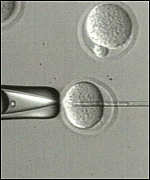
Cloning is the process of creating an identical copy of an original organism or thing. A clone in the biological sense, therefore, is a single cell (like bacteria, lymphocytes etc.) or multi-cellular organism that has been directly copied from, and is therefore genetically identical to, another living organism. Sometimes this term can refer to "natural" clones made either when an organism reproduces asexually or when two genetically identical individuals are produced by chance (as with identical twins), but in common parlance, a clone is an identical copy created intentionally.
The term clone is derived from the Greek word for "twig". In horticulture, the spelling clon was used until the twentieth century; the final e came into use to indicate the vowel is a "long o" instead of a "short o". Since the term entered the popular lexicon in a more general context, the spelling clone has been used exclusively.
Molecular cloning refers to the procedure whereby a DNA sequence is amplified by genetic engineering techniques. Cloning is frequently employed to amplify DNA fragments containing genes, an essential step in their subsequent analysis. Frequently, the term cloning is misleadingly used to refer to the identification of the chromosomal location of a gene associated with a particular phenotype of interest. In practice, localisation of the gene does not always enable one to amplify the relevant genomic sequence.
Cloning of any DNA sequence involves the following four steps: amplification, ligation, transfection, and screening/selection. Initially, the DNA fragment of interest needs to be amplified (many copies need to be produced). Amplification is commonly achieved by means of PCR. Subsequently, a ligation procedure is employed whereby the amplified fragment is inserted into a vector. The vector (which is frequently circular) is linearised by means of restriction enzymes, and incubated with the fragment of interest under appropriate conditions that allow for ligation. The yield of the ligation is typically low and depends on the procedure employed. Following ligation the vector with the insert of interest is transfected to cells. Most commonly electroporation is employed, although a number of alternative techniques are available. Finally, the transfected cells are cultured. As the aforementioned procedures are of particularly low yield, there is the need to identify the cell colonies that have been transfected with the construct of interest containing the desired insertion sequence. Modern cloning vectors include selectable antibiotic resistance markers, which allow only for cells in which the vector has been transfected to grow. However this selection step does not guarantee that the DNA insert is present in the vector. Further investigation of the resulting colonies is required to confirm that cloning was successful. This can be accomplished by means of blue/white screening and/or PCR, possibly followed by DNA sequencing.
Cloning a cell means to derive a (clonal) population of cells from a single cell. This is an important in vitro procedure when the expansion of a single cell with certain characteristics is desired, for example in the production of gene-targeted ES cells. Most individuals began as a single cell and are therefore the result of clonal expansion in vivo.
Cloning means to create a new organism with the same genetic information as a cell from an existing one(identical). It is an asexual method of reproduction, where fertilization or inter-gamete contact does not take place. In a modern context, this can involve somatic cell nuclear transfer in which a cell of the organism to be cloned, with its nucleus containing the DNA, is transferred into an egg cell which has had its nucleus removed. As the nucleus contains almost all of the genetic information of a lifeform, the "host" egg cell will develop into an organism with genetically identical nuclear DNA to the nucleus "donor".
However, this process does not conserve the mitochondrial genome (of the nucleus donor) unless the nucleus and egg cell donor were from the same maternal lineage. Also mutations occur with every cell division so no two cells in an individual are identical, nor are clones. Thus, nuclear transfer clones from different maternal lineages are not clones in the strictest sense because the mitochondrial genome is not the same as that of the nucleus donor cell from which it was produced. This may have important implications for cross-species nuclear transfer in which nuclear-mitochondrial incompatibilities may lead to inviability.
The first animal clone was a frog, cloned by Thomas J. King and Robert W. Briggs in 1952.
Horticultural -- The term clone is used in horticulture to mean all descendants of a single plant, produced by vegetative reproduction or apomixis. Many horticultural plant cultivars are clones, having been derived from a single individual, multiplied by some process other than sexual reproduction. As an example, some European cultivars of grapes represent clones that have been propagated for over two millennia. Other examples are potato and banana. Grafting can be regarded as cloning, since all the shoots and branches coming from the graft are genetically a clone of a single individual, although the root systems may be genetically different for each grafted plant. Other important horticultural cloning methods are cuttings, tissue culture, layering and storage organs, such as bulbs, tubers and corms. These are genuine examples of cloning in the broader biological sense, as they create genetically identical organisms by biological means, but this particular kind of cloning has not come under ethical scrutiny and is generally treated as an entirely different kind of operation.
Natural clones -- Cloning is very common in single-celled organisms, which clone themselves via binary fission, e.g. paramecium, bacteria, many algae. Cloning is also very widespread in plants, where it is often called vegetative reproduction. Vegetative reproduction in plants often involves the formation of adventitious roots or shoots.
Many trees, shrubs, vines, ferns and other herbaceous perennials form clonal colonies. Parts of a large clonal colony often become detached from the parent, termed fragmentation, to form separate individuals. Some plants also form seeds asexually, termed apomixis, e.g. dandelion.
Cloning exists in nature in some animal species and is referred to as parthenogenesis. An example is the "Little Fire Ant" (Wasmannia auropunctata), which is native to Central and South America but has spread throughout many tropical environments. In this species, circumstantial evidence from microsatellite DNA suggests that both queens and males may reproduce clonally in one population in Suriname. Some animals can clone themselves via fragmentation, e.g. starfish.
Ethical issues of cloning -- See also: Christian views on cloningRoman Catholicism and many conservative Christian groups have opposed human cloning and the cloning of human embryos, believing that a human life begins the moment a human egg becomes fertilized. Other Christian denominations such as the United Church of Christ do not believe a fertilized egg constitutes a living being, but still they oppose the cloning of embryonic cells. The World Council of Churches, representing nearly 400 denominations worldwide, opposed cloning of both human embryos and whole humans in February 2006. The United Methodist Church opposed research and reproductive cloning in May 2000 and again in May 2004.
Libertarian views on the subject suggest that it is within a person's constitutional rights to conduct this process, similar to abortion rights.
At present, the main objection to human cloning is that the cloned individual may be biologically damaged, due to the inherent unreliability of its origin: researchers currently are unable to safely and reliably clone non-human primates.
However, as cloning research and methods improve, concerns of safety and reliability will no longer be an issue. Other arguments against cloning come from various religious orders (believing cloning violate's God's will or the natural order of life), and a general discomfort some have with the idea of "meddling" with the creation and basic function of life. This unease often manifests itself in contemporary novels, movies, and popular culture, much like numerous other scientific discoveries and inventions before. Various fictional scenarios portray clones being unhappy, soulless, or unable to integrate into society.
Furthermore, clones are often depicted not as unique individuals but as "spare parts," providing organs for the clone's original (or any non-clone that requires replacement organs).
Needless to say, cloning is a poignant and important topic, reflected by its frequent discussion and debate among politicians, scientists, the media, religions, and the general public.
Health aspects -- The success rate of cloning has been low: Dolly the sheep was born after 277 eggs were to create 29 embryos, which only produced three lambs at birth, only one of which lived, Dolly. 70 calves have been created from 9,000 attempts and one third of them died young; Prometea took 328 attempts, and, more recently, Paris Texas was created after 400 attempts. Notably, although the first clones were frogs, no adult cloned frog has yet been produced from a somatic adult nucleus donor cell.
There were early claims that Dolly the Sheep had accelerated aging. Aging of this type is thought to be due to shortening of telomeres, regions at the tips of chromosomes which prevent genetic threads fraying every time a cell divides. Over time telomeres get worn down until cell-division is no longer possible - this is thought to be a cause of aging. However, subsequent studies showed that, if anything, Dolly's telomere were longer than normal. Dolly died in the year of 2003. Ian Wilmut said that Dolly's early death had nothing to do with cloning but with a respiratory infection common to lambs raised inside like Dolly.
Consistent with Dolly's telomeres being longer, analysis of the telomeres from cloned cows showed they they were also longer. This suggests clones could live longer life spans although many died young after excessive growth. Researchers think that this could eventually be developed to reverse aging in humans, provided that this is based chiefly on shortening of telomeres. Although some work has been performed on telomeres and aging in nuclear transfer clones, the evidence is at an early stage.
-
Dolly (1996-2003-), a ewe, was the first mammal to have been
successfully cloned from an adult cell. She was cloned at the Roslin
Institute in Scotland and lived there until her death when she was 6.
Her birth was announced on 1997-02-22.The name "Dolly" came from a
suggestion by Jesse Haase who helped with her birth, in honor of Dolly
Parton, because it was a mammary cell that was cloned. The technique
that was made famous by her birth is somatic cell nuclear transfer, in
which a non-reproductive cell containing a nucleus is placed in a
de-nucleated ovum (which then develops into a fetus). When Dolly was
cloned in 1996 from a cell taken from a six-year-old ewe, she became the
center of much controversy that still exists today.
-
On 2003-04-09 her stuffed remains were placed at Edinburgh's Royal
Museum, part of the National Museums of Scotland.Ian Wilmut's role in
cloning Dolly the sheep is in doubt. In 2006 he admitted under oath in a
Scottish court that he did not clone Dolly the Sheep and was not
responsible for the scientific breakthrough which made it all possible.
He credited somebody called Keith Campbell as being the brains behind
Dolly the Sheep.
Human cloning is the creation of a genetically identical copy of an existing, or previously existing human or growing cloned tissue from that individual. The term is generally used to refer to artificial human cloning; human clones in the form of identical twins are commonplace, with their cloning occurring during the natural process of reproduction.
Cloning extinct and endangered species
Cloning, or more precisely, the reconstruction of functional DNA from extinct species has, for decades, been a dream of some scientists. The possible implications of this were dramatized in the best-selling novel by Michael Crichton and high budget Hollywood thriller Jurassic Park. In real life, one of the most anticipated targets for cloning was once the Woolly mammoth, but attempts to extract DNA from frozen mammoths have been unsuccessful, though a joint Russo-Japanese team is currently working toward this goal.
In 2000, a cow named Bessie gave birth to a cloned Asian gaur, an endangered species, but the calf died after two days.
In 2003, a banteng was successfully cloned, followed by three African wildcats from a thawed frozen embryo. These successes provided hope that similar techniques (using surrogate mothers of another species) might be used to clone extinct species. Anticipating this possibility, tissue samples from the last bucardo (Pyrenean Ibex) were frozen immediately after it died.
Researchers are also considering cloning endangered species such as the giant panda, ocelot, and cheetah. The "Frozen Zoo" at the San Diego Zoo now stores frozen tissue from the world's rarest and most endangered species.
In 2002, geneticists at the Australian Museum announced that they had replicated DNA of the Thylacine (Tasmanian Tiger), extinct about 65 years previous, using polymerase chain reaction.
However, on 2005-02-15 the museum announced that it was stopping the project after tests showed the specimens' DNA had been too badly degraded by the (ethanol) preservative. Most recently, on 2005-05-15, it was announced that the Thylacine project would be revived, with new participation from researchers in New South Wales and Victoria.
One of the continuing obstacles in the attempt to clone extinct species is the need for nearly perfect DNA. Cloning from a single specimen could not create a viable breeding population in sexually reproducing animals. Furthermore, even if males and females were cloned, the question would remain open if they would be viable at all in the absence of parents that could teach or show them natural behavior.
Essentially, if cloning an extinct species succeeded - it must be considered that cloning still is an experimental technology that succeeds only by chance - it is far more likely than not that any resulting animals, even if they were healthy, would be little more than curios or museum pieces.
Cloning endangered species is a highly ideological issue. Many conservation biologists and environmentalists vehemently oppose cloning endagnered species - not because they think it won't work but because they think it may deter donations to help preserve natural habitat and wild animal populations.
The "rule-of-thumb" in animal conservation is that, if it is still feasible to conserve habitat and viable wild populations, breeding in captivity should not be undertaken in isolation.In a 2006 review, David Ehrenfeld concludes that cloning in animal conservation is an experimental technology that, at its present state, cannot be expected to work except by pure chance and utterly fails a cost-benefit analysis.
Furthermore, he says, it is likely to siphon funds from established and working projects and does not address any of the issues underlying animal extinction (such as habitat destruction, hunting or other overexploitation, and an impoverished gene pool). While cloning technologies are well-established and used on a regular basis in plant conservation, care must be taken to ensure genetic diversity.
Panda cloning 'faces last hurdle' November 2002 - BBC
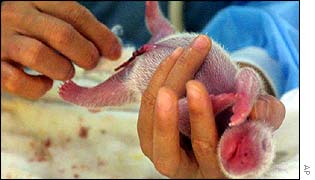
China has cleared two major hurdles in its quest to clone the highly endangered giant panda and just one problem remains to be surmounted, the scientist leading the project says. Chen Dayuan said researchers had worked out how to create a panda embryo using an egg cell from another species and implant the embryo in the uterus of a surrogate mother, also of a different species.
Panda clone could save species BBC - June 22, 1999
Chinese scientists say they have successfully produced an embryo clone of a giant panda, and are hoping that it will now develop to maturity. They are hailing it as a possible breakthrough in their efforts to save one of the world's most endangered species. Only about 1,000 pandas live in the wild, with another 100 in zoos. They are notoriously reluctant to reproduce, and experts have warned that the animal could be extinct within 25 years. The state-run Xinhua news agency said researchers from the Chinese Academy of Sciences introduced genetic material from a dead female panda into the egg cells of a white rabbit. The resulting embryo was nurtured over 10 months and scientists are now trying to implant it in a host animal's uterus.
Cloning Cats
First kittens for cloned wildcats BBC - August 22, 2005
A conservation institute in the United States has produced wildcat kittens by cross-breeding cloned adults. The Audubon Center for Research of Endangered Species says this is the first time that clones of a wild species have bred. Eight kittens have been born in two litters over the last month, and all are apparently doing well. The researchers say this development holds enormous potential for preserving a range of endangered species.
Texas researchers clone cat -Copy Cat' BBC - February 2002
Researchers in Texas have cloned a domestic cat, producing a two-month-old kitten called CopyCat. The work is described in the scientific journal Nature and is the first time anyone has cloned a pet.
Cloning Cows
Scientists clone endangered Asian wild cattle - bantengs CNN - April 2003
A pair of banteng calves born last week were cloned from an animal that died more than 20 years ago
GM cheese from cow clones BBC - January 2003
Cows are being modified to produce drugs and improved milk Scientists in New Zealand have created the world's first cow clones that produce special milk that can increase the speed and ease of cheese-making.
Cloning Carp
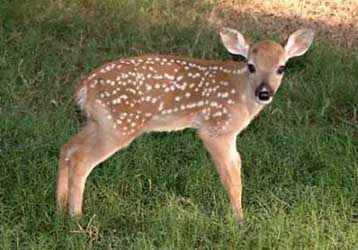
December 23, 2003 - Reuters
Scientists at Texas A&M University have produced what they believe is the first cloned deer, the school says. Tests have confirmed that a fawn named Dewey born to a surrogate mother in May was a genetic duplicate of a male white-tailed deer from southern Texas whose skin samples were used in the cloning process, the school said.
Photos posted on the Texas A&M Internet site Monday showed the little gray deer standing in a patch of grass. "Dewey is developing normally for a fawn his age and appears healthy," said Dr. Mark Westhusin, who was lead investigator on the project. Even though white-tailed deer are abundant in the wild, Westhusin said in a statement the creation of Dewey could prove helpful in preserving endangered species such as the Key West deer of Florida. Texas A&M, located in College Station, Texas 90 miles northwest of Houston, said it was the first academic institution to have cloned five different species. Its scientists have also cloned cattle, goats, pigs and a cat, the school said.
Science moves on from dog clone BBC - March 8, 2006
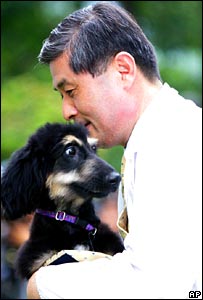
Snuppy, the cloned dog created by disgraced South Korean scientist Hwang Woo-suk, has been formally confirmed as an authentic genetic copy.
South Korea unveils first dog clone BBC - August 3, 2005
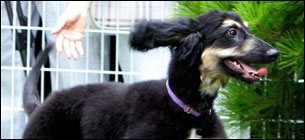
Cloning Extinct Species
Tasmanian Tiger

May 28, 2002 - CNN - Sydney, Australia
This breakthrough allows the scientists to produce millions of pure copies of undamaged DNA fragments which they believe can work in a living cell. Director of the Australian Museum Professor Mike Archer told CNN that the PCR process only worked if DNA being used was viable. "This technique was an extremely critical step in producing sufficient amounts of Tasmanian Tiger DNA to proceed with the research and extremely good news for future steps in accomplishing this project," he said. The next stage is to make large quantity copies of all the genes of the Tasmanian Tiger so these can be used to construct synthetic chromosomes. Archer said there was now not a "massive technical barrier" to producing Tasmanian Tiger clones, "only a hell of a lot of hard work. The big challenge now is the creation of the genetic library."
Archer said some scientists believed the first cloned tiger pup could be born within a decade, but timing was difficult to predict because of the unknowns ahead in such a project. No other long extinct species has ever been cloned, although unsuccessful attempts have been made to extract DNA from a frozen mammoth. The museum is currently working on viable DNA from three Thylacines -- two females and a male -- and hopes to get access to more DNA to enable it to develop sufficient genetic variation.
He said Australia was "out in front of the rest of the world" with this work, but far greater resources were now needed to complete the project. "We are looking for some significant players to help," he said, adding that the project was attracting considerable international interest. Archer said if the cloning of the Tasmanian tiger was successful, it could spark attempts to revive other extinct species. While stories abound that some Thylacines continue to live in the remote wilds of Tasmania, there has been no verified sightings nor reliable evidence to support this.
Cloning Goats
April 28, 1999 - Toronto - CP
Montreal scientists have cloned triplet goats in what is believed to be a world first. The goats -- Danny, Clint Scotland, originated from a cell extracted from an adult sheep, making her a replica of a sheep six years older. Work to produce the identical goats started eight months ago, said Jeffrey Turner, Nexia's president and a former genetics professor at McGill University.
The goats originated from cells transferred from the body of one goat into another goat's mature fertilized eggs. The eggs had their original nuclei, or DNA, removed and replaced by DNA derived from cells grown in the laboratory. The research involving the goats will be used to develop man-made spider silk for medical uses, said Turner. After tracking the health of the goats for a few months, scientists plan to use the cloning process again. Next time, they will inject the silk gene from spiders into the cells that will produce new cloned goats, said Turner.
Cloning Horses
Champion Horse Cloned by Texas Breeder National Geographic - April 5, 2006
Champion endurance horse cloned BBC - April 2005

Researchers give clone health warning BBC - August 2003
Cloning Humans

US team makes embryo clone of men BBC - January 17, 2008
Scientists Make Human Embryo Clones National Geographic - January 17, 2008
UK scientists clone human embryo BBC - May 20, 2005
South Korea: Scientists clone 30 human embryos BBC - February 2004

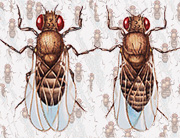
Nature - November 1, 2004
As if there weren't enough of them in the world already, scientists have succeeded in cloning flies. The identical fruitflies are the first insects ever cloned, says the Canadian team that created them. The question everyone asks, says group leader Vett Lloyd of Dalhousie University in Halifax, Nova Scotia, is why anyone would want to clone flies in the first place. She hopes that the insects, which are very easy to experiment with, will help to fine-tune the cloning process in other animals and even in humans, where the technique is being researched to aid production of therapeutic stem cells.
In cloning, the DNA-containing nucleus of an adult cell is injected into an egg whose own nucleus has been removed. At the moment, the majority of cloned mice, sheep and other animals die before birth. It is thought this is because the adult DNA is not properly 'reprogrammed' and cannot orchestrate the growth of an embryo.
Using flies, researchers might reveal genes that are important for this reprogramming, and that have counterparts in other animals. That is because it is relatively easy in flies to knock out the function of a single gene and then attempt cloning with these cells, which will test whether that gene is crucial. If such genes are identified, then in theory cloned mammalian embryos might be grown in tailored solutions that alter the activity of those genes to improve the technique's success rate.
Although some groups have attempted to clone insects before, Lloyd says this is the first time it has been successful. The team used a slight variation on the standard cloning process: they transferred nuclei taken from embryos rather than fully-fledged adult cells. They sucked several nuclei out of developing fly embryos, and injected them into a fertilized fly egg. From over 800 initial attempts, they conjured five adult insects, the group reports in the journal Genetics.
Keith Latham, who studies mouse cloning at Temple University School of Medicine in Philadelphia, Pennsylvania, points out that embryonic cells are much easier to reprogramme than adult cells. "I'm not sure there are many close parallels to what's going on in mammals," he says. Lloyd acknowledges this, and says the group are now working towards creating clones from adult fly cells.
Cloning Carp
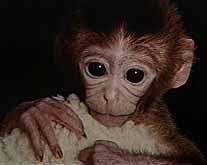
Researchers clone monkey by splitting embryo
CNN - January 13, 2000
Oregon researchers say they have cloned a monkey by splitting an early-stage embryo and implanting the pieces into mother animals. The technique has so far produced only one living monkey, a bright-eyed rhesus macaque female named Tetra, now 4 months old. Professor Gerald Schatten, a researcher at the Oregon Health Sciences University in Portland who led the research, said four more animals are on the way."This is essentially the method of Brave New World," said Ronald M. Green, an ethicist at Dartmouth College. "This opens the prospect of mass identical replication."
Tetra the monkey is different from Dolly the sheep, which was produced by Scientists at Scotland's Roslin Institute using a process called nuclear transfer -- taking the nucleus out of an adult cell and using it to reprogram an unfertilized egg. Some scientists argue that animals like Dolly are not 100 percent clones because they have genetic material both from the adult cell they were taken from, and from the egg that is hollowed out to make the clone. Tetra was produced by a technique called "embryo splitting." Here's how it works:
- An egg from a mother and sperm from a father are used to create a fertilized egg.
- After the embryo grows into eight cells, researchers split it into four identical embryos, each consisting of just two cells.
- The four embryos are then implanted into surrogate mothers. Schatten said that in effect, a single embryo becomes four embryos, all genetically identical.
The babies are due in May. "It is possible that we will have genetically identical monkeys born to different mothers," he said. Schatten says the "embryo splitting" process is similar to what happens in nature when a mother has twins. "This is just artificial twinning," he said. The method is commonly used in animals such as cattle but had never before been used to create a monkey. The technique also has been used to create clones of human embryos at least once. In 1993 Dr. Jerry Hall said he had cloned human embryos by splitting them, although he said the clones were destroyed.
Why do scientists need identical monkeys?
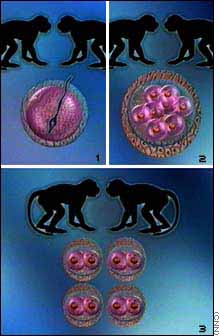
Currently, most medical therapies are first tested in mice, but monkeys are much closer to human biology and would be more reliable in developing daring new techniques such as gene therapy or growing new organs using stem cells, Schatten said. "It is a huge leap from a mouse to a patient," Schatten said. "The monkeys could fill that scientific gap." But Schatten said it's virtually unknown for identical twin rhesus monkeys to be produced naturally. "What we're on the road towards is making identical twins, identical triplets, and the identical quads which could serve as the models for treating the life-threatening diseases that still plague us today," he said.
"This is very exciting and very important," said Dr. John Strandberg with the National Institutes of Health. "I can't think of a single kind of monkey-based research that wouldn't benefit from using identical animals."Strandberg said identical animals are so valuable that researchers often inbreed mice or rats to obtain nearly the same effect.
Testing nature against nurture
Cloned monkeys also would also facilitate an important of test the old argument of whether nature or nurture plays a bigger role in development of offspring. "We could learn what the environmental effect is, separate from genetics," Schatten said. "There are theories that maternal environment can result in an IQ drop of around 10 points. "There are theories that influences in pregnancy have consequences very late in life, he said. For example, the children and even grandchildren of malnourished women may be prone to heart disease and diabetes."By taking say a set of triplets and putting them into three different moms ... you could have one mom listen to Mozart, another heavy metal and maybe NPR (U.S. National Public Radio) for a third. And maybe you could have the very same baby born in the very same mom but in a sequential pregnancy."
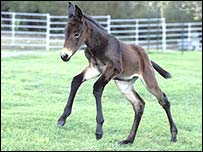
May 29, 2003 - BBC
Scientists in the United States have announced the birth of the world's first cloned mule. The foal, called Idaho Gem, is nearly a month old and appears to be perfectly healthy, the researchers say. The first clone of any animal in the horse family.They suggest their work could lead to champion racehorses being routinely cloned in the future. The research is published in the journal Science.
Idaho Gem looks the perfect foal from his pointy ears to his still slightly unsteady legs. His birth sets a number of milestones. Gem is not only the first cloned mule, he is the first clone of any animal in the horse family; and he is the first clone of an animal which cannot normally reproduce. Mules are almost always sterile. They are formed when a male donkey breeds with a female horse; horses have 64 chromosomes, donkeys 62 - mules end up with 63. The success rate from cloning was typically low - from over three hundred embryos, only three viable foals developed; Gem himself plus two brothers which are yet to be born.
New race
The research was sponsored by an American mule-racing enthusiast; but the real implications could lie in horse-breeding. The scientist in charge of Gem's creation, Professor Gordon Woods of the University of Idaho, says the team has solved a technical hurdle which has until now prevented cloning in any member of the horse family. The cloning success rate was 1 in 100
So cloning champion racehorses or show-jumpers should now be possible. "It could also help with endangered species," said Professor Woods, "species like the Przewalski horse."
International horse-racing rules currently outlaw any form of assisted reproduction, including cloning; but show-jumping has no such rules. Male show-jumping horses are routinely castrated, so cannot breed - making cloning, perhaps, an attractive option for their owners. Jacky Knightley, a spokeswoman for the British Show-Jumping Association, commented that cloning would take all the fun out of breeding, and could make the sport as boring as Formula One motor racing.
Cloning Pigs
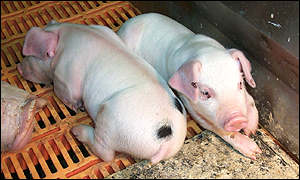
Chinese scientists produce country's first cloned pig PhysOrg - August 8, 2005
Mini-pig clone raises transplant hope January 2003 - New Scientist
The small pig's organs are similar in size to those of humans and the missing genes make the organs less likely to be rejected.
Behavior of Cloned Pigs January 2003 - Science Daily
Variation within a litter of clones was as variable or greater than the normal litters at least 80 percent of the time for.
Rare pig breed cloned - April 2002 - BBC
US scientists have cloned a rare breed of pig in an experiment they say shows the copying technology can be made more efficient. The cloned animal, called Princess, was the last female in one of only four bloodlines of Gloucestershire Old Spots in North America. Several attempts at getting offspring from Princess through natural breeding and artificial insemination had failed, NewScientist.com reports. Cloning produced three piglets, born via a surrogate mother, after just one embryo implantation round.
Cloning Carp

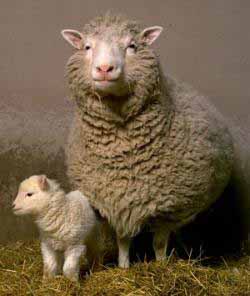
It all began with Dolly the Sheep in 1996. Dolly (5 July 1996 Ð 14 February 2003), a ewe, was the first mammal to have been successfully cloned from an adult cell. She was cloned at the Roslin Institute in Midlothian, Scotland, and lived there until her death when she was six years old. Her birth was announced on 22 February 1997.
The sheep was originally code-named "6LL3". The name "Dolly" came from a suggestion by the stockmen who helped with her birth, in honour of Dolly Parton, because it was a mammary cell that was cloned. The technique that was made famous by her birth is somatic cell nuclear transfer, in which a cell is placed in a de-nucleated ovum, the two cells fuse and then develop into an embryo. When Dolly was cloned in 1996 from a cell taken from a six-year-old ewe, she became the center of much controversy that still exists today.
On 9 April 2003 her stuffed remains were placed at Edinburgh's Royal Museum, part of the National Museums of Scotland.
Dolly was created by a research team managed by Ian Wilmut at the Roslin Institute in Scotland. The goal of the research was the reliable reproduction of animals genetically modified to produce therapeutic proteins in their milk. Wilmut's team had already created 2 sheep clones from embryonic cells grown in culture called Megan and Morag; the work was published in Nature in 1996. Dolly was a Finn Dorset lamb, created from fully differentiated adult mammary cells using a technique called somatic cell nuclear transfer; her creation was described in a Nature publication in 1997. Dolly was the first mammalian clone produced from an adult cell.
In 1999 research was published in the journal Nature suggesting that Dolly may have been susceptible to premature aging, due to shortened telomeres in her cells. It was speculated that these were passed on from her donor sibling, who was six years old when the genetic material was taken from her, so that Dolly may have been genetically six years old at birth. This is because telomere length is reduced after each cell division, which requires DNA replication before mitosis occurs.
The polymerase, part of the replication machinery, cannot reach the end of the chromosome being replicated and clips a little of the telomere at the end off every time replication occurs. However, Dr. Sean Lamb indicated that most cloned animals actually have telomeres of normal length and in serial clones the telomeres are actually getting longer in each successive generation.
This is because the enzyme telomerase is active in those clones, which keeps the telomeres from shortening. However, telomerase, which is present in many bacteria, can be responsible for causing mutation through its enzymatic activity, which leads to cancer. In fact, in the course of carcinogenesis many human cancer cells produce telomerase, which is not normally present in adult human cells.
Possible signs of her condition were reported in January 2002, when Dolly was five years old. She had developed a potentially debilitating form of arthritis at an unusually early age. This supported the theory of premature senescence, although Dr. Dai Grove-White of the Faculty of Veterinary Science at Liverpool University was reported as saying, "Conceivably arthritis could be due to the cloning but equally it could not be. For all we know, she may have damaged her leg jumping over a gate and developed arthritis."
Others speculate that Dolly's arthritis resulted from her lifestyle as a scientific curiosity and protected specimen due to a lack of normal outdoor exercise and unnatural stress on her joints.The arthritis further fueled worry among some that this form of cloning may not be appropriate for mammals, and there is now a consensus both in- and outside scientific community that at this point the risk of unforeseen effects of cloning on the clone makes experiments in human reproductive cloning premature and unethical.
Supporters of this method of cloning counter that the technique used to clone Dolly simply needs to be refined. However, others contend that with very limited understanding of the nascent field of applied genetics, scientists can not and should not attempt to control the action of so many genes at once. Many outside the scientific community have stated that this is vindication for their initial assertions that any form of cloning is ethically wrong and should be banned.
On February 14, 2003 it was announced that Dolly had died from a progressive lung disease. A necropsy confirmed she had Ovine Pulmonary Adenocarcinoma (Jaagsiekte), a fairly common disease of sheep caused by a retrovirus. Roslin scientists stated that they did not think there was a connection with Dolly being a clone, and that other sheep on the farm had similar ailments. Such lung diseases are especially a danger for sheep kept indoors, as Dolly had to be for security reasons.
Legacy -- After the cloning was successfully demonstrated by Dolly's creators , many other large mammals have been cloned, including horses and bulls. Cloning is now considered a promising tool for preserving endangered species, usually by those who do not work in species conservation.
Most animal conservation professionals point out that cloning does not alleviate the problems of loss of genetic diversity (see inbreeding) and habitat, ergo must be considered an experimental technology for the time being, and all in all would only rarely be worth the cost, which on a per-individual basis far exceeds conventional techniques such as captive breeding or embryo transfer.
The 2000-2001 attempt to clone a gaur failed, with the animal, "Noah", dying 2 days after birth, and the attempt to clone argali sheep did not produce viable embryos. The attempt to clone a banteng bull was more successful, as were the attempts to clone mouflon, both resulting in viable offspring.
The banteng example is a case illustrating the circumstances under which the uncertainties of cloning attempts are outweighed by the benefits: the cell donator was an adult of a rare genotype combination which had been killed in a fight.
The first reported case of successful cloning was in 1952 with a tadpole. Briggs and King (1952) used nuclei from Blastula stage embryos. The host unfertilized egg was first enucleated. The blastula stage donor nucleus was removed from the embryo blastomere using a micropipet and then microinjected into the enucleated egg cytoplasm. This experiment was repeated 100-200 times. The injected host eggs activated, started to cleave and in many cases (80%) developed into swimming tadpoles. The blastula nuclear genome was directing the development of the new embryo up to the tadpole stage. Therefore, blastula nuclei appear to be totipotent.
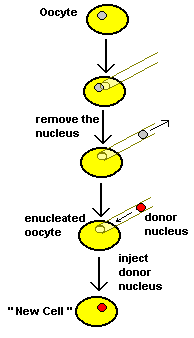
Gurdon (1962) used donor nuclei from older tadpole differentiated intestinal cells. The rest of the procedure was the same as shown above. A small number (2-5%) of the nuclear tranplants developed into swimming tadpoles. The problem is, did Gurdon inject an intestinal cell nucleus? Remember, the PGCs are migrating out of the gut of the tadpole. Gurdon may have used a PGC nucleus and not an intestinal cell nucleus in the transplant. Even with the poor results, Gurdon claimed that fully-differentiated intestinal nuclei are still totipotent
California: World's oldest tree cutting collected for cloning
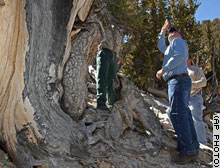
October 2002 - CNN
A nonprofit group has snipped some cuttings to clone what is believed to be the world's oldest tree, a bristlecone pine they say has grown for 4,767 years on a wind-swept mountain in eastern California. With the guidance of a U.S. Forest Service ranger, representatives from Michigan-based Champion Tree Project International hiked Tuesday to the tree, at an elevation of 10,400 feet in the White Mountains on the California-Nevada border. The tree was dubbed Methuselah after scientist Edmund Schulman found it and age-dated it by a core sample in the 1950s. Although the name is biblical, the tree is believed to predate Christ by almost 3,000 years. "It's healthy," said David Milarch, co-founder with his son of the tree project. "It's gnarly from almost 5,000 years of harsh weather. But they got plenty of good material."
The specimens to Chris Friel, a doctoral student in plant pathology at UC Davis who is trying to clone the tree. "Within a year, either I'll have an itty bitty little tree or I won't," Friel said. "Frankly, the chances on an ancient tree are extremely slim." David Milarch said the Methuselah tree stands about 55 feet tall, with a misshapen oval-shaped trunk measuring about 41/2 feet wide.
Jared Milarch and Mock also took samples for cloning from a bristlecone pine believed to be the largest of the species and growing in the same forest -- a 60-foot tall tree known as "the Patriarch." Richard Harris, a forestry specialist at the University of California, Berkeley, said it was possible that the Methuselah tree was the oldest in the world. However, he said boring provides only an age estimate, and noted the difficulty of accurately counting 4,767 rings in a core sample from a twisted bristlecone trunk just 41/2 feet across.
The Forest Service backed the Champion Tree Project's efforts to clone prized trees for research and to restock sparse forest areas, Payne said. The nonprofit National Tree Trust also helped the effort. The Milarches began the Champion Tree Project in 1996, and have attempted to clone more than 70 trees nationwide. The organization provided a clone from a 450-year-old champion red ash for planting at a September 11 Pentagon memorial. It also collected bits of poplar trees said to have been planted by George Washington on his estate, Mount Vernon, and expect to return clones for replanting. "We're finding the last genetic links to forests that were here for tens of thousands of years," David Milarch said. ShareThis .
No comments:
Post a Comment